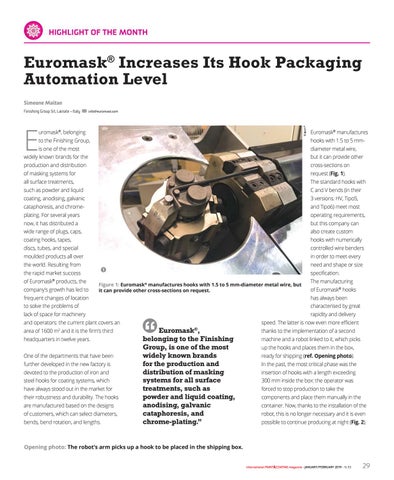HIGHLIGHT OF THE MONTH
Euromask® Increases Its Hook Packaging Automation Level Simeone Maitan Finishing Group Srl, Lainate – Italy
info@euromask.com
© ipcm ®
E
uromask®, belonging
Euromask® manufactures
to the Finishing Group,
hooks with 1.5 to 5 mm-
is one of the most
diameter metal wire,
widely known brands for the
but it can provide other
production and distribution
cross-sections on
of masking systems for
request (Fig. 1).
all surface treatments,
The standard hooks with
such as powder and liquid
C and V bends (in their
coating, anodising, galvanic
3 versions: HV, Tipo5,
cataphoresis, and chrome-
and Tipo6) meet most
plating. For several years
operating requirements,
now, it has distributed a
but this company can
wide range of plugs, caps,
also create custom
coating hooks, tapes,
hooks with numerically
discs, tubes, and special
controlled wire benders
moulded products all over
in order to meet every
the world. Resulting from of Euromask products, the ®
company’s growth has led to
need and shape or size
1
the rapid market success
specification.
Figure 1: Euromask® manufactures hooks with 1.5 to 5 mm-diameter metal wire, but it can provide other cross-sections on request.
The manufacturing of Euromask® hooks
frequent changes of location
has always been
to solve the problems of
characterised by great
lack of space for machinery
rapidity and delivery
and operators: the current plant covers an area of 1600 m2 and it is the firm’s third headquarters in twelve years. One of the departments that have been further developed in the new factory is devoted to the production of iron and steel hooks for coating systems, which have always stood out in the market for their robustness and durability. The hooks are manufactured based on the designs of customers, which can select diameters, bends, bend rotation, and lengths.
speed. The latter is now even more efficient
Euromask®, belonging to the Finishing Group, is one of the most widely known brands for the production and distribution of masking systems for all surface treatments, such as powder and liquid coating, anodising, galvanic cataphoresis, and chrome-plating.”
thanks to the implementation of a second machine and a robot linked to it, which picks up the hooks and places them in the box, ready for shipping (ref. Opening photo). In the past, the most critical phase was the insertion of hooks with a length exceeding 300 mm inside the box: the operator was forced to stop production to take the components and place them manually in the container. Now, thanks to the installation of the robot, this is no longer necessary and it is even possible to continue producing at night (Fig. 2).
Opening photo: The robot’s arm picks up a hook to be placed in the shipping box.
international PAINT&COATING magazine - JANUARY/FEBRUARY 2019 - N. 55
29
